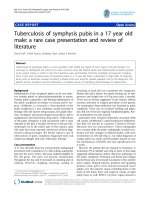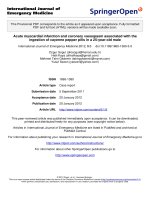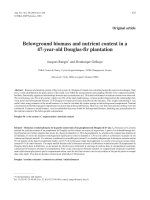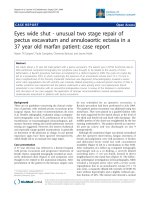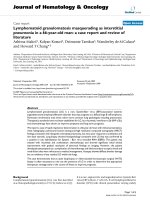Toxoplasma, Toxocara and Tuberculosis co-infection in a four year old child
Bạn đang xem bản rút gọn của tài liệu. Xem và tải ngay bản đầy đủ của tài liệu tại đây (240.73 KB, 3 trang )
Guneratne et al. BMC Pediatrics 2011, 11:44
/>
CASE REPORT
Open Access
Toxoplasma, Toxocara and Tuberculosis
co-infection in a four year old child
Randeewari Guneratne1, Devan Mendis2, Tharaka Bandara1 and Sumadhya Deepika Fernando3*
Abstract
Background: Tuberculosis. toxocariasis and toxoplasmosis are among the common infectious causes of
lymphadenitis in children. Cases of Toxoplasma gondii and Toxocara spp co-infection have been reported.
Case Presentation: This case report describes a co-infection of Toxoplasma gondii, Toxocara spp and tuberculosis
in a child with chronic lymphadenopathy and eosinophilia.
Conclusion: The case report highlights two important points. First is the diagnostic challenges that are
encountered by clinicians in tropical countries such as Sri Lanka, where lymphadenopathy and eosinophilia with a
positive serology commonly point towards a parasitic infection. Secondly the importance of proper history taking
and performing the Mantoux test as a first line investigation in a country where the incidence of tuberculosis is
low, even in the absence of a positive contact history.
Background
Tuberculosis. toxocariasis and toxoplasmosis are among
the common infectious causes of lymphadenitis in children
[1]. Approximately 250,000 children worldwide develop
tuberculosis, a larger proportion being reported from the
South East Asian region [2,3]. Extra-pulmonary tuberculosis is more common in children, the most common form
being lymphatic disease accounting for about two thirds of
the cases of extra-pulmonary tuberculosis [4-6].
Toxoplasma gondii and Toxocara spp. infections are
cosmopolitan zoonotic diseases which may cause systemic and ocular diseases in humans [7-9]. Few publications exist regarding Toxoplasma and Toxocara coinfection [10,11].
This case report describes a child with chronic lymphadenopathy and eosinophilia who was seropositive for
both Toxoplasma gondii and Toxocara spp, together
with a positive Mantoux test and lymph node histology
suggesting tuberculosis.
Case Presentation
A 4 year-old, previously healthy boy was admitted to the
surgical unit of the Colombo South Teaching Hospital,
* Correspondence:
3
Professor in Parasitology, Department of Parasitology, Faculty of Medicine,
University of Colombo, Colombo, Sri Lanka
Full list of author information is available at the end of the article
Sri Lanka with an abscess in the left big toe. No fever or
local lymphadenopathy was present at initial presentation. The abscess was drained, treated with antibiotics
and the child was discharged. Two weeks later the child
was re-admitted with an infection at the site of original
abscess and left sided inguinal lymphadenopathy. Full
blood count (FBC) revealed an eosinophilia of 12.5%
(WBC count 19,800, N 40.8%, L 35.9%). Blood picture
showed moderate eosinophilia with reactive changes
suggestive of either a parasitic infection, or an allergic/
drug reaction. A blood sample was sent for the detection of Toxoplasma and Toxocara antibodies to the
Medical Research Institute (MRI), Colombo. Empirical
treatment was commenced with Diethyl Carbamazine 6
mg/kg/body weight for 14 days and Mebendazole 50 mg
twice a day for 3 days (based on body weight of 13 kg)
together with intravenous antibiotics. The lymph node
enlargement which persisted during the wound infection
resolved with treatment and the child was discharged 14
days after admission.
Three months later the child was referred to the Paediatric Unit of the same hospital with reports of the
blood sample taken at the time of previous admission
indicating positive serology for both Toxoplasma gondii
and Toxocara spp (Toxoplasma antibody IgG Negative,
IgM Positive and Toxocara antibody IgG Positive).
Examination of the child at this instance revealed
© 2011 Guneratne et al; licensee BioMed Central Ltd. This is an Open Access article distributed under the terms of the Creative
Commons Attribution License ( which permits unrestricted use, distribution, and
reproduction in any medium, provided the original work is properly cited.
Guneratne et al. BMC Pediatrics 2011, 11:44
/>
bilateral cervical (2 cm) and left side inguinal (3 cm)
lymph nodes, and non tender hepatomegaly approximately 2 cm from the costal margin. No splenomegaly
was noted. There was no history of fever, cough, wheezing or recurrent infections. No weight loss, night sweats
or chronic cough suggestive of tuberculosis was
recorded. There was no contact history of tuberculosis
though intensive questioning of the parents revealed a
history of lymphadenopathy due to tuberculosis in the
elder sibling, approximately one year before this child
was born. The sibling had been treated with the full
course of anti-tuberculosis treatment based on the
WHO recommendations [12] and was healthy thereafter.
There was no association with cats or ingestion of
undercooked meat though there was a history of close
contact with dogs which were not de-wormed.
The patient was re-admitted to the Paediatric Unit.
Full blood count and blood picture was repeated and
FBC showed a total count of 16,500 with 18.5% eosinophils (N 29%, L 46% M 5.4%). The blood picture was
similar to the previous report. Ultrasound Scan abdomen confirmed mild hepatomegaly 3 cm from costal
margin but no splenomegaly or para-aortic lymph node
enlargement. As toxoplasmosis is generally a self- limiting disease in this age group, the child was treated with
high doses of Albendazole (50 mg/kg per day in two
divided doses to a maximum dose of 400 mg daily for 5
days) for toxocariasis.
Mantoux test was positive, suggesting co-existing
tuberculosis in this child. Chest x- ray did not show any
lesions suggestive of pulmonary tuberculosis. An inguinal lymph node biopsy was taken for histology on the
5th day of treatment with Albendazole. A repeat FBC
indicated that the blood counts were within normal
range (Total count 10,800, N 47%, L 51%, M 1%, E 1%).
However, the lymph node enlargement persisted.
The biopsy report of the left inguinal lymph node
which was received two weeks later, indicated central
necrosis with numerous tuberculoid type granulomata.
Granulomata consisted epithelioid histiocytes. Langerhans type giant cells seen in central caseous necrosis.
The appearance was compatible with tuberculous lymphadenitis with no evidence of Toxoplasma or Toxocara
in the lymph node sample.
The parents were requested to take the child to the
national chest clinic for anti tuberculosis treatment with
instructions to report back to the Paediatric clinic with
results of antibody tests for toxoplasmosis and toxocariasis both in the mother and child and an HIV Profile of
the child. Acute Toxoplasma and Toxocara infection
was confirmed in the child with positive anti Toxoplasma IgM and IgG antibodies and a four-fold rise in
the IgG titre for toxocariasis as compared to the results
Page 2 of 3
taken 3 months previously justifying the treatment for
toxocariasis. The HIV screening was negative. All test
results were negative in the mother. The parents were
requested to repeat the tests 6 months after completion
of treatment and advice given to prevent re-infection of
zoonotic parasitic diseases. They were also educated
about tuberculosis and the importance of completing
the full course of treatment.
Conclusions
This case report highlights two important points. Firstly
this child had a co-infection of toxocariasis, toxoplasmosis and tuberculosis and secondly diagnostic challenges
were encountered by the clinicians as lymphadenopathy
and eosinophilia commonly point towards a parasitic
infection. The high eosinophil count with lymphadenopathy, positive serology and blood picture reports combined with a mild hepatomegaly could have limited the
final diagnosis to Toxoplasma, Toxocara co-infection
and the child may have been discharged following the
appropriate treatment. This highlights the importance of
proper history taking and performing the Mantoux test
as a first line investigation even without a positive contact history in a country like Sri Lanka where the prevalence of tuberculosis is low [13]. As the risk of
tuberculosis progression is high in very young children
(<3 years), should the disease have not been detected
the consequences may have been severe [14]. Transmission of tuberculosis occurred from an infectious person,
possibly the elder sibling or a source in their community. Pinpointing the source of the tuberculosis infection
may be particularly challenging in this case as the parents indicated that the sibling received full treatment at
the time of diagnosis. Only genotyping would confirm
whether this child and the sibling were infected with the
same strain which is beyond the scope of this report.
The Medical Research Institute is one of the two government institutes in the country which carries out tests
for anti Toxocara and Toxplasma antibodies free of
charge. Results of repeat antibody tests carried out 3
months after the first test confirms an acute Toxoplasma and Toxocara infection. Seroprevalence of Toxocariasis in Sri Lanka is shown to be 43% in rural areas
[15] and 20% in urban hospital population [16]. Human
toxocariasis gives a diversity of clinical conditions ranging from non-specific covert toxocariasis to compartmentalized (ocular or neurological) toxocariasis [17].
Confirmation of these parasitic infections with investigations other than antibody tests proves difficult due to
inadequate resources and the large patient numbers presenting to the state run institutes. Treatment is provided
free of charge by the Government of Sri Lanka. As Toxoplasma causes a self- limiting infection in children no
Guneratne et al. BMC Pediatrics 2011, 11:44
/>
treatment was given. The child was treated for toxocariasis to prevent visceral migration of the parasite.
Abbreviations
FBC: Full blood count; WBC: White blood cell count; N: Neutrophils; L:
Lymphocytes; M: Monocytes; E: Eosinophils
Acknowledgements
We wish to thank the parents of this child for giving consent for writing up
this case report.
Financial Assistance: None
Author details
1
Intern House Officer, Colombo South Teaching Hospital, Kalubowila, Sri
Lanka. 2Consultant Paediatrician, Colombo South Teaching Hospital,
Kalubowila, Sri Lanka. 3Professor in Parasitology, Department of Parasitology,
Faculty of Medicine, University of Colombo, Colombo, Sri Lanka.
Page 3 of 3
15. Iddawela DR, Kumarasiri PVR, Wijesundera M de S: A seroepidemiological
study of toxocariasis and risk factors for infection in children in Sri
Lanka. Southeast Asian J Trop Med Pub Health 2003, 34:7-15.
16. Fernando SD, Wickramasinghe VP, Kapilananda GMG, Dewasurendra RL,
Amarasooriya JDMS, Dayaratne HGAK: Epidemiological aspects and risk
factors of toxocariasis in a pediatric population in Sri Lanka. Southeast
Asian J Trop Med Pub Health 2007, 38:983-90.
17. Pawlowski Z: Toxocariasis in humans: clinical expression and treatment
dilemma. J Helminthol 2001, 75:299-5.
Pre-publication history
The pre-publication history for this paper can be accessed here:
/>doi:10.1186/1471-2431-11-44
Cite this article as: Guneratne et al.: Toxoplasma, Toxocara and
Tuberculosis co-infection in a four year old child. BMC Pediatrics 2011
11:44.
Authors’ contributions
RW, DM and TB managed the patient during his stay in hospital and
followed up on the patient there after. SDF was responsible for interpreting
the results of the serological tests and drafting the manuscript. All authors
read and approved the final manuscript.
Competing interests
The authors declare that they have no competing interests.
Received: 2 February 2011 Accepted: 26 May 2011
Published: 26 May 2011
References
1. Lymphadenopathy. In Nelson Textbook of Pediatrics.. 17 edition. Edited by:
Behrman RE, Kliegman RM, Jenson HB. Philadelphia: Elsevier Science (USA);
2003:1678-79.
2. World Health Organization Fact sheets: Tuberculosis. [.
int/mediacentre/factsheets/fs104/en/].
3. World Health Organization Communicable Diseases: tuberculosis; TB and
Children Fact Sheet. WHO Regional office for South East Asia. [http://
www.searo.who.int/en/Section10/Section2097/Section2106_10681.htm].
4. Özvaran MK, Baran R, Tor M, Dilek I, Demiryontar D, Arinc S, Toker N,
Chousein EU, Soğukpinar Ö: Extra-pulmonary tuberculosis in non-human
immunodeficiency virus-infected adults in an endemic region. Ann
Thorac Med 2007, 2(Suppl 3):118-21.
5. Gonzalez OY, Adams G, Teeter LD, Bui TT, Musser JM, Graviss EA: Extrapulmonary manifestations in a large metropolitan area with a low
incidence of tuberculosis. Int J Tuberc Lung Dis 2003, 7:1178-85.
6. Ussery XT, Valway SE, McKenna M, Cauthen GM, McCray E, Onorato IM:
Epidemiology of tuberculosis among children in the United States.
Pediatr Infect Dis J 1996, 15:697-704.
7. Dubey JP, Beattie CP: Toxoplasmosis of Animals and Man Florida, USA: CRC
Press Boca Raton; 1988.
8. Tenter AM, Heckeroth AR, Weiss LM: Toxoplasma gondii: from animals to
humans. Int J Parasitol 2000, 30:1217-58.
9. Hill D, Dubey JP: Toxoplasma gondii: transmission, diagnosis and
prevention. Clin Microbiol Inf Dis 2002, 8:634-40.
10. Jones JL, Kruszon-Moran D, Won K, Wilson M, Schantz PM: Toxoplasma
gondii and Toxocara spp. Co-infection. Am J Trop Med Hyg 2008, 78(Suppl
1):35-9.
11. Salil KG, Littlewood JM: The Clinical Picture of Coexisting Toxoplasma and
Toxocara Infection and Its Management: A Small Child with a Rare
Double Infection. Clin Pediatr 1976, 15:31-3.
12. WHO: Treatment of tuberculosis: guidelines. World Health Organization
Press; 2009.
13. World Health Organization. Tuberculosis in South East Asia: Country
Profile, Sri Lanka. WHO Regional Office for South East Asia. [http://www.
searo.who.int/en/Section10/Section2097/Section2100_14802.htm].
14. WHO: Guidance for National Tuberculosis programme on the
management of tuberculosis in children. World Health Organization
Press; 2006.
Submit your next manuscript to BioMed Central
and take full advantage of:
• Convenient online submission
• Thorough peer review
• No space constraints or color figure charges
• Immediate publication on acceptance
• Inclusion in PubMed, CAS, Scopus and Google Scholar
• Research which is freely available for redistribution
Submit your manuscript at
www.biomedcentral.com/submit
